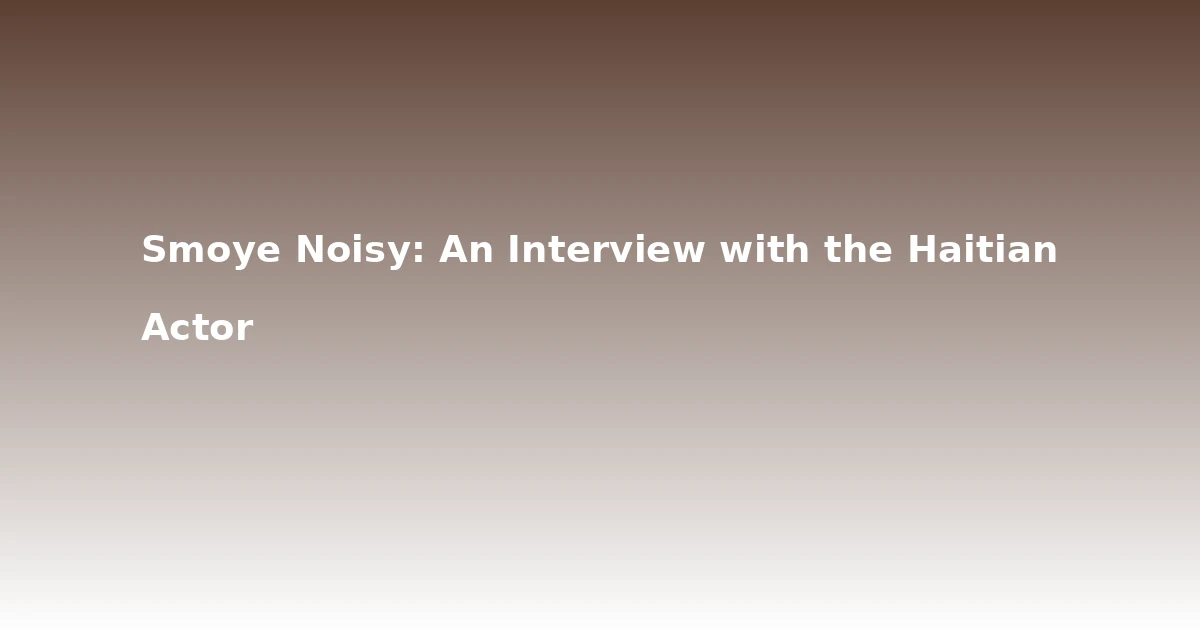Listening to the poetry flowing from the mouth of spoken word artist Melissa Beauvery is quite a treat. She makes her poetic presentations at times entirely in Creole, with English sprinkled in from time to time. And at times in English, with a few Creole words thrown in.
Blocks of words are accompanied by a hand gesture, a sneer, a dramatic tilt of the head—when the words call for it.
Born in New York to US-born and raised parents of Haitian descent, Beauvery released , a disc of her spoken word compositions. The collection consists of tributes to the women—the hard-working women of Haiti.
In the extremely moving “Pye Fanm” [The Feet of Women], Beauvery makes some impressive analysis about the feet of mothers and market women in Haiti—how their laboriousness can sometimes be measured by the appearance of their feet.
“Li gen plis grenn ke berejjènn”—she has more seeds than an eggplant. So begins “Fanm Kanson” (Women with Pants), one of the most arresting pieces from the pen of Ms. Beauvery. But there are others equally striking—mainly “My Grandmother’s Tongue”, a piece that compares a grandmother’s scolding words to a Shakespearan verse.
Beyond that, it is about a woman’s relationship with her grandmother, and inter-generational misunderstandings. It’s a nod to that spot over the cultural fence, where Haitian sits alongside American, and occasionally clash.
“You smell like a hardworking woman/I want to smell /Your stench is more appealing than any French perfume you receive on Christmas,” muses Beauvery in one verse. Beauvery may have meant to only speak of her grandmother, but plenty will find themselves drawn to “My Grandmother’s Tongue”—especially those whose grandmothers have always meant so much to them.
So much more than an elderly lady with a tin cup at her bedside for her dentures.
Q & A
Growing up Haitian is different for everyone. What was the Melissa Beauvery experience like?
Growing up Haitian has influenced my pride in my culture. I spoke Creole at home, my mother was constantly communicating with friends and family in Haiti and Haitian friends in the states.
I ate Haitian food for lunch, it wasn’t “lunchables” or sandwiches for lunch like my friends in school. I was taught to handwash my underwear every day at a young age. I periodically drank bitter teas. I had the ribbons in my hair unlike the braids and beads of my friends.
I knew at a young age that being Haitian in America made me different. Growing up in Brooklyn has definitely allowed my art to be as diverse as my setting. For example, when I was a child, I took ballet lessons, as well as Haitian folkloric dance.
Two different worlds and two different set of friends. In my writing there is a strong presence of my American background even in my Haitian Creole poetry. I often hear that my accent and even delivery is definitely not as of a “Haitian” poet.
I am great influenced by American poets as much as Haitian Writers. I still have that Brooklyn in my tongue. I was fortunate to get the taste of both worlds in artistically.
What can you tell us about your first spoken word record My Grandmother’s Tongue?
My Grandmother’s Tongue is really an ode to my grandmother and all that she has invoked within me. I always loved storytelling. I never took advantage of informal storytelling of my elders. The verbal flashbacks about Haiti, adolescence and what happened on a particular day.
So for my first project, I wanted it to be formal and informal storytelling which largely rests in tone, emotion and pace of one’s voice. So with My Grandmother’s Tongue, I tried to incorporate all these elements plus the magic of instruments that shared a humane depiction of the Haitian experience in Haiti and abroad.
Each of the 9 tracks shares a completely different message and takes on its own life.
“Pye Fanm” is so amazing. Did a trip to Haiti inspire it?
Writing in Creole is quite a challenge because I often feel insecure as an American-born writer to express myself in such a colorful language. I was on my grandmother’s porch in Miragoane, Haiti when I was inspired to to write “Pye Fanm”.
I was about 18 at the time and during my stay in Miragoane my favorite thing to do was so sit on the porch and watch all “machanns” [street vendors] pass by early the in the morning on their way to the market place.
I had a few machanns that I was particularly on the lookout for because I know that if I didn’t catch them early in the morning I was out of luck until dusk.
So every morning, I particularly waited for “Machann bonbon siwo” [molasses bar vendor] and one image that stayed with me were their dusty feet. Each “machann” had the same dusty feet and rubber or leather sandals that were worn out. That image made me pay more attention and I started to write in my daily journal exactly what I saw. I actually wrote the poem “Pye Fanm” years later.
A great deal of your spoken word work is in Creole.
Creole equals my grandmother’s tongue. My very first example of my Haitian Identity was listening to my grandmother speak through recorded tapes. My mother played them constantly. I immediately fell in love with Creole and I always wanted to use those words as much as I heard them and poetry has allowed me to do that.
Anyone who’s listened to your spoken word performances and who has made themselves familiar with your poetry can see this tendency in you to put women at the forefront. Obviously, your grandmother has been very influential. But what other Haitian women have you found especially inspiring?
I have never been so proud so proud to be a female artist of Haitian descent. So many Haitian women blow me away.
I was also honored to work with that is highlighting Haitian women and women all over the world I am inspired by so many Haitian women but on the top of my head I would say the following women have inspired my Heart: Toto Bissainthe, Martha Jean-Claude, Carole Demesmin.
Myriam Dorisme, Emeline Michel, Rosy Cadet, Yole Derose, Ginou Oriol, Edwidge Danticat, Francesa Andre, Michele Voltaire Marcelin, Marylin Laurent, Yanick Lahens, Jennifer Celestin, Jeanie Bogart, Nathalie Cerin, Lahiny Pierre, Ella Turenne, Lenelle Moise, Val Jeanty, Ibi Zoboi. This list can really go on and and on. For consecutive decades, Haitian women have really stand forth in their identities, bodies and hearts speaking their truth. All of these women truly deserve crowns.
Any historical ones?
Definitely! Anacaona, the maroon women, Cecile Fatiman, Zabet, Defilee, Catherine Flon, Marie-Jeanne, Empress Marie-Claire Heureuse and Empress Adelina. History and storytelling are so close for me, I am as charmed reading history articles and books just as much as I am charmed reading creative writings.
When was the last time you went to Haiti?
Last year, around the time I released my CD, I went through what I would call a quarter life crisis [Chuckles]. I really couldn’t understand what what going on in my life and what I should be doing. After releasing my CD, I went to Haiti for a few months.
I was originally just supposed to stay during the summer to volunteer with The Youth Agency’s summer program for young children. I ended up staying over four months. My last stay in Haiti changed my life.
It’s as if I had an epiphany. I understand my purpose much clearer now.
Do you remember the first time you went to Haiti?
My first memory of Haiti was when I was four years old. I don’t remember the whole airport experience but I remember the car stopping in front of my grandparent’s home in the countryside.
My niece at the time was two years old and she was standing in front of the house eating kowosòl—sour sop—she had no shoes on, looked as if she was running and had the fruit all over her face.
I had never seen that fruit before. Stepping to the muddy road holding my mother’s hand, we walked to the house and my niece gave some of the fruit. I nearly choked on my seeds and my grandfather bent down and with patience showed how it eat them. I will never forget that moment.
A lot of spoken word artists were inspired by novelists and poets. Was that the case with you?
Besides the name on the list of women that has inspired me, I would say Langston Hughes, Richard Wright, James Baldwin, Jacques Roumain, Jacques Stephen Alexis, Maurice Sixto, Rene Depestre, Franketienne, Toni Morrison, Gwendolyn Brooks, Sonia Sanchez, Rita Dove, Alice Walker and Octavia Butler.I am honestly more of an admirer/ reader than a writer.
I am always enchanted to read some of my favorite writers.
What are you most proud of so far?
I was most proud of my volunteering work last year in Haiti. The sole purpose of my art is to really give back. I believe in art’s ability to change lives.
I also taught English classes and pottery. I connected and bonded with so many amazing people. It was the purest feeling of joy I have ever experienced. I miss Haiti every day.
How do you decide how to perform a new piece?
Depending on the event, time of year and crowd, I select the poem that speaks to me. And if I am given enough time and feel inspired, I write a completely new piece in addition to other pieces I normally perform.
Do you sometimes find yourself performing certain pieces differently, depending on your audience?
I am always nervous, no matter how many times I have performed. I have serious stage fright. Even in an audience of predominantly non-Creole speakers, I always recite one poem in Creole. It is always so wonderful to hear how much they love the sound of Creole.
I become even more proud of where I come from. When I am in a mostly Haitian audience, I am always so self-conscious about my accent. And I certainly keep my more sensual poems for adult crowds in a lounge or evening party settings.
For those out there, who are wanting to be spoken word artists, can you share some drops of wisdom with them?
If your imagination and words sit heavy in your chest, speak! I would also tell anyone that is considering working on their craft to remember that no one can share their story better than them.
Be brave, be open and tell a story that doesn’t want to leave their hearts.
Photos: Courtesy of Melissa Beauvery and by Francesca Andre; main photo by Ashley Panzara
You can purchase Melissa Beavery’s My Grandmother’s Tongue
Last Updated on December 4, 2025 by kreyolicious



